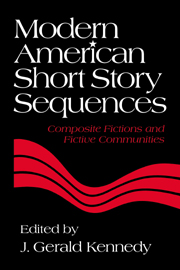Book contents
- Frontmatter
- Contents
- Contributors
- Introduction: The American Short Story Sequence – Definitions and Implications
- Henry James's Incipient Poetics of the Short Story Sequence: The Finer Grain (1910)
- Toomer's Cane as Narrative Sequence
- Hemingway's In Our Time: The Biography of a Book
- Wright Writing Reading: Narrative Strategies in Uncle Tom's Children
- The African-American Voice in Faulkner's Go Down, Moses
- Meditations on Nonpresence: Re-visioning the Short Story in Eudora Welty's The Wide Net
- Nine Stories: J. D. Salinger's Linked Mysteries
- Cheever's Shady Hill: A Suburban Sequence
- John Updike's Olinger Stories: New Light Among the Shadows
- Louise Erdrich's Love Medicine: Narrative Communities and the Short Story Sequence
- From Anderson's Winesburg to Carver's Cathedral: The Short Story Sequence and the Semblance of Community
- Index
Wright Writing Reading: Narrative Strategies in Uncle Tom's Children
Published online by Cambridge University Press: 29 September 2009
- Frontmatter
- Contents
- Contributors
- Introduction: The American Short Story Sequence – Definitions and Implications
- Henry James's Incipient Poetics of the Short Story Sequence: The Finer Grain (1910)
- Toomer's Cane as Narrative Sequence
- Hemingway's In Our Time: The Biography of a Book
- Wright Writing Reading: Narrative Strategies in Uncle Tom's Children
- The African-American Voice in Faulkner's Go Down, Moses
- Meditations on Nonpresence: Re-visioning the Short Story in Eudora Welty's The Wide Net
- Nine Stories: J. D. Salinger's Linked Mysteries
- Cheever's Shady Hill: A Suburban Sequence
- John Updike's Olinger Stories: New Light Among the Shadows
- Louise Erdrich's Love Medicine: Narrative Communities and the Short Story Sequence
- From Anderson's Winesburg to Carver's Cathedral: The Short Story Sequence and the Semblance of Community
- Index
Summary
Beginning with the Bible and proceeding all the way through the spirituals and blues, novel, poem, and the dance, Negro Americans have depended upon the element of narrative for both entertainment and group identification.
Ralph EllisonIs the fiction of [the] world … capable of speaking itself and of displaying itself as a form of a story, necessary for the establishment of that moral authority without which the notion of a specifically social reality would be unthinkable?
Hayden WhiteRichard Wright, angry isolato, Communist Captain, and expatriate, first from the South and then from America, seems in many ways an unlikely writer to associate with Ellison's pronouncement. A more obvious candidate would be his old literary nemesis, Zora Neale Hurston, who built her narratives on leisurely pastoral, bright bolts of black music and folklore, dance, and a cornucopia of humor. Wright, in his rage, generally grim tone, and driven prose, seems diametrically opposed to the folk narrative in his moods and objectives. But many of our conceptions about Wright stem from an overconcentration on his angry, neo-gothic urban masterwork, Native Son. He could, and did, use folk materials to lend vitality to his realism, to ground his reinscriptions of memory and history, and to introduce his gospel of Communist brotherhood and struggle. Indeed, the book that preceded Native Son, Uncle Tom's Children, a sequence of short stories/novellas, commences in “Big Boy Leaves Home” with disembodied voices of the folk:
- Type
- Chapter
- Information
- Modern American Short Story SequencesComposite Fictions and Fictive Communities, pp. 52 - 75Publisher: Cambridge University PressPrint publication year: 1995



